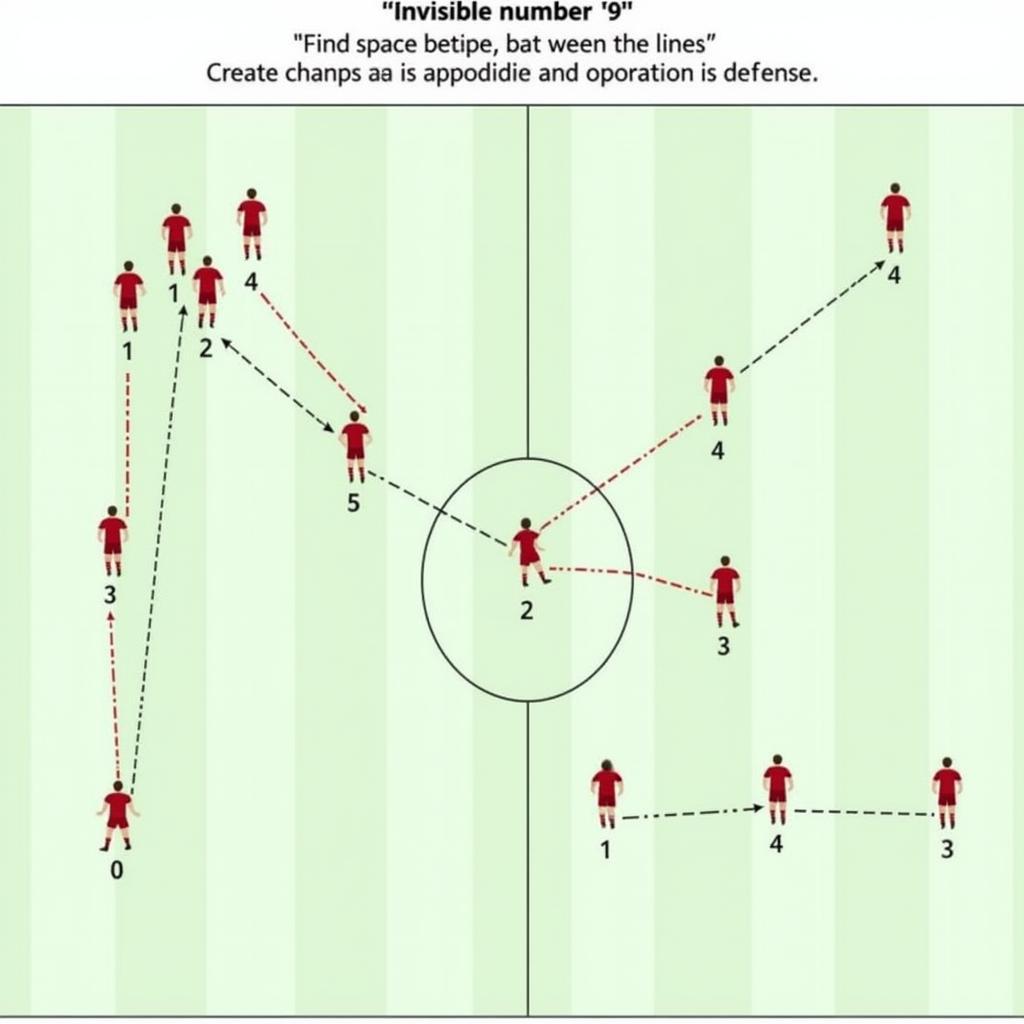The Mystery of Football’s Invisible Number 9s
October 18, 2024For decades, the number 9 shirt has been synonymous with prolific goalscorers, from Ronaldo Nazário to Robert Lewandowski. But what about the “invisible” number 9s – those players who may not wear the iconic jersey but possess the skillset and tactical awareness to operate effectively as a hidden striker? These players often fly under the radar, their contributions sometimes overlooked in favor of flashier teammates, but their impact on a team’s success is undeniable.
 Football Tactics: Invisible Number 9
Football Tactics: Invisible Number 9
Decoding the Invisible Number 9
An “invisible number 9” is not defined by the number on their back but by their playing style and tactical role. They might wear the number 10, 11, or even 7, yet their movement and contributions resemble a traditional center forward. These players are masters of space, drifting into pockets between the opposition’s midfield and defense, creating havoc with their intelligent movement and passing.
Think of players like Lionel Messi during his time at Barcelona or Thomas Müller at Bayern Munich. They possess the creativity and vision of attacking midfielders, but their off-the-ball movement and ability to ghost into scoring positions make them incredibly dangerous in the final third. They might not be target men, but their ability to link-up play, create chances for themselves and their teammates, and exploit defensive vulnerabilities make them a nightmare for defenders.
The Tactical Advantages of an Invisible Number 9
Deploying an “invisible number 9” offers several tactical advantages. Firstly, it allows for greater fluidity in attack. These players are constantly on the move, pulling defenders out of position and creating space for overlapping full-backs and midfield runners. This constant movement makes it difficult for the opposition to track and contain, leading to defensive errors and goalscoring opportunities.
Secondly, it adds an element of surprise. Opponents often focus on marking the traditional number 9, leaving the “invisible” counterpart with more freedom to operate. This can be particularly effective against teams that rely on man-marking systems, as the “invisible number 9” can disrupt their defensive structure with their unpredictable movement.
Identifying the Invisible Number 9s of Today
The modern game is witnessing a resurgence of the “invisible number 9” role. 8 cầu thủ hà nội possess the versatility and intelligence to excel in this position. They may not fit the mold of a traditional center forward, but their impact on the game is undeniable.
Here are a few examples of players who embody the “invisible number 9” style:
-
Kai Havertz (Chelsea): Known for his technical prowess and intelligent movement, Havertz often operates as a false 9, dropping deep to link up play and create chances for teammates.
-
Roberto Firmino (Liverpool): During Liverpool’s dominant run under Jürgen Klopp, Firmino epitomized the “invisible number 9” role. His relentless pressing, intelligent movement, and unselfish play were crucial to their success.
-
Antoine Griezmann (Atlético Madrid): While capable of leading the line, Griezmann’s versatility allows him to excel as a second striker or an attacking midfielder, drifting into dangerous positions and creating havoc with his passing and movement.
These are just a few examples of the many talented players who are redefining the role of the number 9. Their ability to seamlessly blend into the attack, create chances, and score goals makes them invaluable assets to their teams.
The Future of the Invisible Number 9
As football continues to evolve, the “invisible number 9” role is likely to become even more prominent. The modern game demands versatility, intelligence, and adaptability – qualities that are essential for this unique position. Players who can operate effectively in tight spaces, link up play with midfielders, and exploit defensive vulnerabilities will be highly sought after.
The “invisible number 9” might not always grab the headlines, but their contributions are essential for teams looking to gain a tactical advantage. As the lines between traditional positions continue to blur, the ability to play this role effectively will be crucial for success at the highest level.
Conclusion
The “invisible number 9” is a testament to the ever-evolving nature of football. It’s a role that requires a unique blend of technical ability, tactical awareness, and footballing intelligence. These players might not always wear the iconic number 9 shirt, but their impact on the game is undeniable. As we look to the future, it’s clear that the “invisible number 9” will continue to play a vital role in shaping the tactical landscape of the beautiful game.